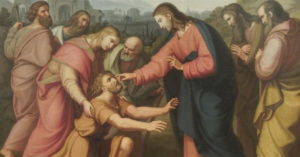Mount Calvary will livestream its mass at 10 AM on Sunday March 22 at this YouTube channel. The arrangement of the church permits the presence of a small choir, so the mass will be a sung High Mass with this music. There will be no congregation.
Jesus heals the man born blind
Mount Calvary Church
Lent IV
Laetare Sunday
_________
Common
Missa de Angelis
__________
Anthems
Come, Let’s rejoice, John Amner (1579-1641)
Come let’s rejoice unto the Lord: let us make joy to God our Saviour. Let us approach to his presence in confession: and in psalms let us make joy to him.
_____
God so loved the world, John Stainer (1840-1901)
God so loved the world that he gave his only begotten Son, that whoso believeth in him should not perish, but have everlasting life. For God sent not his Son into the world to condemn the world, but that the world through him might be saved.
It is from the oratorio The Crucifixion: A Meditation on the Sacred Passion of the Holy Redeemer. John Stainer was an English composer and organist whose music, though not generally much performed today, was very popular during his lifetime. His work as choir trainer and organist set standards for Anglican church music that are still influential. He was also active as an academic, becoming Heather Professor of Music at Oxford.
__________
Hymns
When I survey the wondrous cross (ROCKINGHAM) is by Isaac Watts (1674—1748). When preparing for a communion service in 1707, when he himself was thirty-three years old, Watts wrote this personal expression of gratitude for the love that Christ revealed by His death on the cross. Watts echoes Paul: “But far be it from me to glory except in the cross of our Lord Jesus Christ, by which the world has been crucified to me, and I to the world” (Gal 6: 14). The third stanza repeats almost verbatim phrases from St. Bernard of Clairvaux’s hymn “Salve mundi salutare”: such sentiments would be felt by any sincere Christian who meditated upon the crucifixion.
Edward Miller (1735-1807) adapted ROCKINGHAM from an earlier tune, TUNEBRIDGE, which had been published in Aaron Williams’s A Second Supplement to Psalmody in Miniature (c. 1780). The tune title refers to a friend and patron of Edward Miller, the Marquis of Rockingham, who served twice as Great Britain’s prime minister.
_____
Nearer my God to Thee (BETHANY) is by the Unitarian Sarah Flower Adams (1805-1848). It is based on the story of Jacob’s dream (Genesis 28:10-22), and presents a potent combination of two themes: human suffering (the cross in stanza 1 is not the Cross of Jesus, but a cross that has to be borne) and the merciful presence of God. The stone of Jacob’s pillow becomes the stony griefs out of which the commemorative stone of Bethel will be raised, marking the place where he had his vision of the angels passing up and down between earth and heaven. The hymn rejoices in God, either through sorrow:
...Out of my stony griefs Bethel I'll raise: So by my woes to be Nearer, my God, to thee, Nearer to thee!
or through the joy of flying upward to God:
Or if on joyful wing Cleaving the sky, Sun, moon, and stars forgot, Upwards I fly, Still all my song shall be, Nearer, my God, to thee, Nearer to thee!
The legend is that it was played by the band on the Titanic as the ship was sinking.
The tune BETHANY is by the Presbyterian Lowell Mason (1792-1872), the father of American church music.
_________
Rock of ages (TOPLADY) has been a stay and comfort in days of peril, and in the hour of death. No other English hymn can be named which has laid so broad and firm a grasp upon the English-speaking world. It was written by the Rev. Augustus Toplady (1740–1778), an Evangelical priest of the Church of England, who was first a friend of John Wesley but who quarreled with him over predestination.
The tune TOPLADY is by the American Thomas Hastings (1784-1872). As a teenager, Hastings led a village choir, taught singing, and was active in the musical society of Oneida County. By 1832 he had moved to New York City where he conducted the Bleeker Street Church and by 1858 the University of New York awarded him an honorary Doctorate in Music. He composed over 600 tunes used for hymns.
